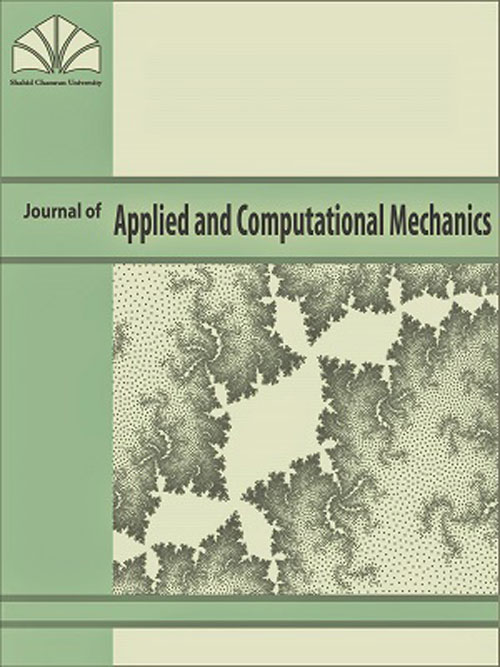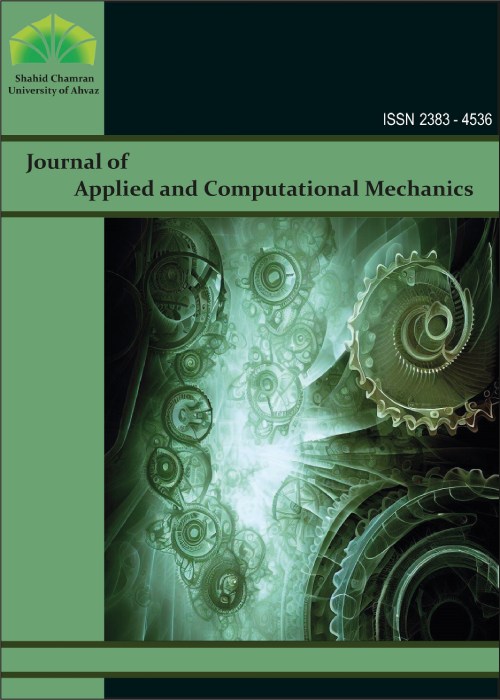فهرست مطالب

Journal of Applied and Computational Mechanics
Volume:3 Issue: 4, Autumn 2017
- تاریخ انتشار: 1396/08/30
- تعداد عناوین: 8
-
-
Pages 229-239In this study, by using the finite volume method, the heat transfer in a convective straight fin with temperature-dependent thermal properties and an internal heat generation under multi-boiling heat transfer modes are analyzed. In this regard, the local heat transfer coefficient is considered to vary within a power-law function of temperature. In the present study, the coexistence of all the boiling modes is taken into consideration. The developed heat transfer models and the corresponding numerical solutions are used to investigate the effects of various thermo-geometric parameters on the thermal performance of the longitudinal rectangular fin. The results shows that the fin temperature distribution, the total heat transfer, and the fin efficiency are significantly affected by the thermo-geometric parameters of the fin and the internal heat generation within the fin. The obtained results can provide a platform for improvements in the design of the fin in the heat transfer equipment.Keywords: Multi, boiling heat transfer, Convective straight fin, Finite volume method, Temperature, dependent properties, Internal heat generation
-
Pages 240-250Steady state natural convection is numerically investigated in an enclosure using variable thermal conductivity, viscosity and thermal expansion coefficient of Al2O3water nanofluid. This study has been conducted for a wide range of Rayleigh numbers (103≤ Ra ≤ 106), concentrations of nanoparticles (0% ≤ Φ ≤ 7%), enclosure aspect ratios (0.5 ≤ AR ≤ 2) and temperature differences between the cold and the hot walls (1≤ ∆T≤ 30). The main idea in this study is about the effect of temperature on natural convection pattern of nanofluid by changing nanoparticles concentration. Also, changing thermal expansion coefficient with temperature is considerd in this study which will have significant effects on natural convection and has not been considerd before. In low Rayleigh numbers (Ra= 103) and for cavities with AR≥1, the pattern shown in the average Nusselt number versus volume fraction of nanoparticles diagram deteriorates by increasing ∆T. However, for other cases, increasing ∆T has a positive effect on Nu-Φ diagram. The actual Nuselt number curve depicts that dispersing nanoparticles in base fluid deteriorate natural convection heat transfer which is in a good agreement with experimental works.Keywords: Nanofluid, Natural convection, variable property
-
Investigation on the Ultrasonic Tube Hydroforming in the Bulging Process Using Finite Element MethodPages 251-257In ultrasonic tube hydroforming, the tube is hydro formed while the ultrasonic vibration is applied to the die. Prior studies provide experimental proof that ultrasonic tube hydroforming reduces corner radius, improves lubrication and uniform thickness. Use of ultrasonic vibration can decrease friction at the tube-die interface. Few attempts have been made to analyze the wire drawing while the ultrasonic vibrations were also applied during the processes. A detailed analysis and understanding of the mechanism of improvement is not possible with conventional experimental observation because the ultrasonic vibration processing phenomenon occurs at high speed. Therefore, we attempt to understand the processing mechanism of ultrasonic tube hydroforming using the finite element method (FEM).ABAQUS was used for the FEM. Forming force and formability in tube hydroforming analyzed. From these studies, we quantitatively clarified the mechanism of improved formability characteristics, such as decreased forming load and increasing bulging diameter.Keywords: tube hydroforming, ultrasonic oscillation, Finite Element Method, bulging process
-
Pages 258-266In this study, the steady incompressible flow of a non-Newtonian sodium alginate (SA) fluid conveying copper nanoparticles (Cu) which flow within two vertical parallel plates is investigated by using the homotopy perturbation analytical scheme to solve the coupled nonlinear ordinary equations arising from the mechanics of the fluid. The developed analytical solutions are used to investigate the effect of the fluid flow and heat transfer parameters such as the nanoparticle concentration, the non-Newtonian parameter and the viscosity variation parameter. The obtained analytical results as compared to existing works in literature are in satisfactory agreements. Moreover, the results obtained from the present study can be used for further analysis of the behavior of the sodium alginate in applications such as food processing and chemical and pharmaceutical industries.Keywords: Sodium alginate, copper, parallel plates, perturbation, Nano fluid, Non, Newtonian
-
Pages 267-273In this study, a method is proposed to determine the fundamental period of layered soil profiles. A model considering the layered soil as shear type structure is used. At first, the soil profile is divided into substructures. Then, the stiffness matrices of the substructures considered as the equivalent shear structures are assembled according to the Finite Element Method. Thereinafter, the stiffness matrices of the substructures are transformed into the Modified Finite Element Transfer Matrices, which take part in the literature. Finally, the system matrix is assembled using matrices of the substructures. The proposed method provides reduction in the size of the matrix. Therefore, analysis time is remarkably reduced. At the end of the study, the accuracy of the method is presented by the examples. Consequently, the proposed method offers a practical method for determination of the fundamental period of the soil.Keywords: Finite element, Soil profile, fundamental period, Transformation, Transfer matrix
-
Pages 274-282This study presents the effect of porosity on mechanical behaviors of a power distribution functionally graded beam. The Euler-Bernoulli beam is assumed to describe the kinematic relations and constitutive equations. Because of technical problems, particle size shapes and micro-voids are created during the fabrication which should be taken into consideration. Two porosity models are proposed. The first one describes properties in the explicit form as linear functions of the porosity parameter. The second is a modified model which presents porosity and Youngs modulus in an implicit form where the density is assumed as a function of the porosity parameter and Youngs modulus as a ratio of mass with porosity to the mass without porosity. The modified proposed model is more applicable than the first model. The finite element model is developed to solve the problem by using the MATLAB software. Numerical results are presented to show the effects of porosity on mechanical behaviors of functionally graded beams.Keywords: Mechanical Behaviors, Porous material, Functionally graded material, Beam Analysis, Finite Element Method
-
Pages 283-292The columns of frame structures are the key load-bearing components and the exterior columns are susceptible to attack in terrorist blasts. When subjected to blast loads, the columns would suffer a loss of bearing capacity to a certain extent due to the damage imparted which may lead to their collapse and even cause the progressive collapse of the whole structure . The concrete-filled steel columns have been extensively used in the world due to the existence of all suitable characteristics of concrete and steel, more ductility, increasing concrete confinement using the steel wall, the large energy-absorption capacity and the appropriate fire behavior. In the present study, the concrete-filled steel square columns have been simulated under the influence of the blast load using the ABAQUS software. These responses have been compared for scaled distances based on the distance to the source and the weight of the explosive material. As a result, it can be seen that although concrete deformation has been restricted using the steel tube, the inner layer of concrete has been seriously damaged and the column displacement has been decreased by increasing the scaled distance. We also concluded that the concrete-filled steel columns have the high ductility and the blast resistance.Keywords: Blast Load, Concrete, Filled Steel Columns, Finite Element Analysis
-
Pages 293-301The U-slot micro-strip patch antennas were originally developed for bandwidth broadening applications. This study presents a transmission line feed to modify the U-slot stacked rectangular micro-strip patch antenna for Ultra-Wide Band (UWB) communications. The modified antenna has a U-cut loaded with parallel slits and corner slots and is printed on a dielectric substrate of FR4 with relative permittivity (εr) of 4.4, the thickness of 1.59 mm and the tangent loss of 0.025. The results show that the proposed antenna achieves an impedance bandwidth of 11.55 GHz (2.1 13.65 GHz) with the return lossKeywords: UWB antenna, VSWR, IE3D, Return Loss


